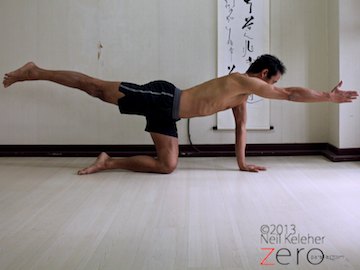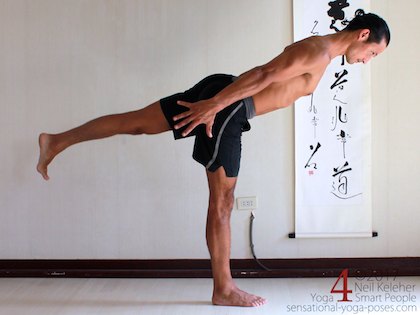Tips for Sequencing Yoga Poses
For a Balanced Yoga Practice (and For Dealing with Problems)

One question when doing your own yoga practice (or teaching yoga) is how to sequence yoga poses.
When I first started doing yoga, I learned Ashtanga Yoga, a set series of yoga poses. (Actually, its a few different series. I learned the first series and dabbled with the second). After studying with Andrey Lappa I began to explore a freestyle format for doing yoga.
A small, but important part of what Andrey taught us was how to use counter poses, balancing the action of one pose with the opposing movement in another pose.
Another important idea, perhaps the most important idea I learned from him, was a way of simplifying complex systems so that they are easier to learn. That is encapsulated neatly in the practice I learned from him that is called The Dance of Shiva.
He took a bit of the mystery out of how to sequence yoga poses creatively while still leaving the body in a balanced state. And you could leave sun salutations (or Surya Namaskar) out of your yoga practice and still effectively warm up the body.
What follows are some ideas for how to sequence yoga poses including some possible benefits of different categories of poses and what to work on if you have problems like tight hamstrings.
Sequencing Yoga Poses 1 | Sequencing Yoga Poses 2
Two Basic Yoga Pose Categories
A starting point for organizing a yoga practice is having a way of categorizing yoga poses.
Two simple and basic categories for yoga poses include standing poses and seated yoga poses.
Why you might choose to do standing yoga poses before seated yoga poses
One way to structure a yoga practice is to do standing yoga poses first followed by seated yoga poses.
Standing yoga poses tend to make you work harder, particularly those where the knees are bent, and so in this regard, standing yoga poses serve as a sort of warm up. Another point about standing yoga poses, particularly in hamstring stretching yoga poses, is that they tend to be easier than their seated counterparts.
Put another way, standing hamstring stretches can be easier, particularly if you have tight hamstrings, than seated hamstring stretches.
Note that another option for working with tight hamstrings is to work on strengthening them first.
More further down below!
Working On Balance While Standing
One way that I like to warm up the body while standing is with balancing yoga poses.
This can be with the intent to improve balance and can include balancing on forefeet or heels, and/or balancing on one foot.
Note that if you have hip, leg or foot imbalances (which may be causing low back pain), balancing on one foot is one way you can go about determining where your imbalances are so that you can fix them.
Some advantages of seated yoga poses
You don't have to do standing yoga poses first.
An advantage of seated yoga poses is that it can be easier to isolate parts of the body or otherwise focus on specific parts of the body.
As an example, it is possible to practice scapular awareness while standing. However, they can also be done while sitting. In addition, it's fairly easy to go from unweighted to weighted shoulder exercises while sitting. So having practiced various unweighted scapular awareness exercises, you could apply that same awareness and control to a pose that involves the shoulder bearing weight such as table top yoga pose.
Decide what you are trying to do
And so when deciding between whether to start with standing yoga poses or seated yoga poses, you can choose depending on what it is that you want to work on in a particular yoga practice.
Dealing with Tight Hamstrings
If you have tight hamstrings, one way you might start a practice is by practicing activating your hamstrings. This is something I often teach while sitting simply because it is easier to do. I then have students practice hamstring activation while standing. From there they can practice activating and relaxing their hamstrings while stretching or strengthening them. While not a method guaranteed to improve hamstring flexibility, it can help.
Because the hamstring tendons interloc with the tendons of the larger calf muscle (the gastrocnemius) you may find it helpful to do calf stretches either before or while you are stretching your hamstrings.
Yoga for Strength
In terms of sequencing yoga poses, arm strengthening exercises can be used as a way of warming up the shoulders in preparation for stretching them.
That being said, if doing active shoulder stretches, then those stretches can be used as a preparation for arm supported yoga poses.
Arm supported yoga poses are poses where one or both arms help support the weight of the body. These are yet another category of yoga poses.
If you use a yoga mat when you practice, and your hamstring flexibility is limited, you can use your yoga mat to improve your grip strength as well as a tool to help strengthen your arms and hamstrings as in these arm strengthening standing forward bends.
Strengthening the Hamstrings
One way to work on tight hamstrings is to work on strengthening them and the glutes (both of which work on the back of the hip joint.). Check out hamstring strengthening exercises for more on this.
Options for strengthening the hamstrings include poses like:
Most of these could be considered backbends for the hips as well as backbends for the spine.
And so another option for sequencing yoga poses when dealing with tight hamstrings is to work on strengthening them (and the glutes) first. If you do this, then while stretching your hamstrings you can play with activating your hamstrings and glutes as if to resist the stretch.
Note, while forward bends are generally considered as hamstring stretches, it is possible to do yoga forward bends for the spine and hips without involving the hamstrings. Some forward bends for the spine (and hips) could be considered as ab strengthening yoga poses or yoga poses for the abs.
Muscle Control and Proprioception
Muscles are an essential part of the bodies proprioceptive mechanism. Muscle power output is information that the brain uses to help figure out how the parts of the body are positioned relative to each other and how the body is positioned relative to the earth. To that end, when warming up, one of the reasons for warming up muscles is to actually turn on proprioception, an essential aspect of doing yoga poses (and any other physical activity.)
This doesn't mean that you need to exert your strength fully in order to turn on proprioception, just enough to turn on muscles so that they can give the brain that information. And so some aspect of turning muscles on can be an important idea when sequencing yoga poses.
More
Sequencing Yoga Poses 2
Published: 2017 06 23
Updated: 2020 10 24





